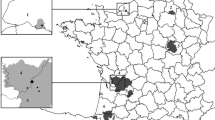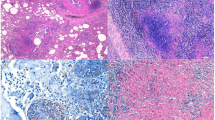Abstract
It has long been theorized that deer mice (Peromyscus maniculatus) are a primary reservoir of Yersinia pestis in California. However, recent research from other parts of the western USA has implicated deer mice as spillover hosts during epizootic plague transmission. This retrospective study analyzed deer mouse data collected for plague surveillance by public health agencies in California from 1971 to 2016 to help elucidate the role of deer mice in plague transmission. The fleas most commonly found on deer mice were poor vectors of Y. pestis and occurred in insufficient numbers to maintain transmission of the pathogen, while fleas whose natural hosts are deer mice were rarely observed and even more rarely found infected with Y. pestis on other rodent hosts. Seroprevalence of Y. pestis antibodies in deer mice was significantly lower than that of several chipmunk and squirrel species. These analyses suggest that it is unlikely that deer mice play an important role in maintaining plague transmission in California. While they may not be primary reservoirs, results supported the premise that deer mice are occasionally exposed to and infected by Y. pestis and instead may be spillover hosts.


Similar content being viewed by others
References
Ben Ari T, Gershunov A, Gage KL, Snall T, Ettestad P, Kausrud KL, Stenseth NC (2008) Human plague in the USA: the importance of regional and local climate. Biology Letters 4:737-40; https://doi.org/10.1098/rsbl.2008.0363
Burroughs AL (1947) Sylvatic plague studies. The vector efficiency of nine species of fleas compared with Xenopsylla cheopis. Journal of Hygiene 45(03):371-96
California Department of Public Health (2016) California compendium of plague control. Sacramento (CA)
Campos EG, Maupin GO, Barnes AM, Eads RB (1985) Seasonal occurrence of fleas (Siphonaptera) on rodents in a foothills habitat in Larimer County, Colorado, USA. Journal of Medical Entomology 22(3):266-270
Cavanaugh D, Thorpe B, Bushman J, Nicholes P, Rust Jr J (1965) Detection of an enzootic plague focus by serological methods. Bulletin of the World Health Organization 32(2):197
Craven RB, Maupin GO, Beard ML, Quan TJ, Barnes AM (1993) Reported cases of human plague infections in the United States, 1970–1991. Journal of Medical Entomology 30(4):758-61
Cully JF, Williams ES (2001) Interspecific comparisons of sylvatic plague in prairie dogs. Journal of Mammology 82(4):894-905
Danforth ME, Novak MG, Petersen J, Mead PS, Kingry LC, Weinburke M, Buttke D, Hacker G, Tucker J, Niemela M, Jackson B, Padgett K, Liebman K, Vugia D, Kramer V (2016) Investigation and response to 2 plague cases, Yosemite National Park, California, USA, 2015. Emerging Infectious Diseases 22(12):2045; https://doi.org/10.3201/eid2212.160560
Davis RM, Smith RT, Madon MB, Sitko-Cleugh E (2002) Flea, rodent, and plague ecology at Chuchupate campground, Ventura County, California. Journal of Vector Ecology 27:107-27
Eisen RJ, Eisen L, Gage KL (2009) Studies of vector competency and efficiency of North American fleas for Yersinia pestis: state of the field and future research needs. Journal of Medical Entomology 46(4):737-44
Eisen RJ, Gage KL (2009) Adaptive strategies of Yersinia pestis to persist during inter-epizootic and epizootic periods. Veterinary Research 40(2):1; https://doi.org/10.1051/vetres:2008039
Eisen RJ, Holmes JL, Schotthoefer AM, Vetter SM, Montenieri JA, Gage KL (2008) Demonstration of early-phase transmission of Yersinia pestis by the mouse flea, Aetheca wagneri (Siphonaptera:Ceratophylidae), and implications for the role of deer mice as enzootic reservoirs. Journal of Medical Entomology 45(6):1160-4
Gage KL, Kosoy MY (2005) Natural history of plague: perspectives from more than a century of research. Annual Review of Entomology 50:505-28; https://doi.org/10.1146/annurev.ento.50.071803.130337
Holt AC, Salkeld DJ, Fritz CL, Tucker JR, Gong P (2009) Spatial analysis of plague in California: niche modeling predictions of the current distribution and potential response to climate change. International Journal of Health Geographics 8:38; https://doi.org/10.1186/1476-072x-8-38
Hubbard CA (1947) Fleas of Western North America: Their Relation to the Public Health; Ames, Iowa: The Iowa State College Press
Hudson B, Kartman L (1967) The use of the passive hemagglutination test in epidemiologic investigations of sylvatic plague in the United States. Journal of Wildlife Diseases 3(2):50-9
Hudson B, Quan S, Goldenberg M (1964) Serum antibody responses in a population of Microtus californicus and associated rodent species during and after Pasteurella pestis epizootics in the San Francisco Bay area. Zoonoses Research 3(1):15-29
Jameson E, Peeters HJ (2004) Mammals of California. Berkeley and Los Angeles, CA: University of California Press
Kartman L, Miles VI, Prince FM (1958) Ecological studies of wild rodent plague in the San Francisco Bay area of California. I. Introduction. American Journal of Tropical Medicine and Hygiene 7(1):112-24
Kartman L, Prince FM (1956) Studies On Pasteurella pestis in fleas. V. The experimental plague-vector efficiency of wild rodent fleas compared with Xenopsylla cheopis, together with observations on the influence of temperature. American Journal of Tropical Medicine and Hygiene 5(6):1058-70
Kosoy M, Reynolds P, Bai Y, Sheff K, Enscore RE, Montenieri J, Ettestad P, Gage K (2017) Small-scale die-offs in woodrats support long-term maintenance of plague in the U.S. southwest. Vector Borne and Zoonotic Diseases 17(9):635-644; https://doi.org/10.1089/vbz.2017.2142
Lewis RE, Haas GE (2001) A review of the North American Catallagia Rothschild, 1915, with the description of a new species (Siphonaptera:Ctenophthalmidae:Neopsyllinae:Phalacropsyllini). Journal of Vector Ecology 26:51-69
Lewis RE, Lewis JH, Maser C (1988) The Fleas of the Pacific Northwest. Corvallis, Oregon: Oregon State University Press
Maestas LP, Britten HB (2017) Flea and small mammal species composition in mixed-grass prairies: implications for the maintenance of Yersinia pestis. Vector-Borne and Zoonotic Diseases 17(7)467-74
Maher SP, Ellis C, Gage KL, Enscore RE, Peterson AT (2010) Range-wide determinants of plague distribution in North America. American Journal of Tropical Medicine and Hygiene 83(4):736-42; https://doi.org/10.4269/ajtmh.2010.10-0042
Nelson BC (1980) Plague studies in California—the roles of various species of sylvatic rodents in plague ecology in California. Proceedings of the Ninth Vertebrate Pest Conference, pp 89–96
Nelson BC, Smith CR (1976) Ecological effects of a plague epizootic on the activities of rodents inhabiting caves at Lava Beds National Monument, California. Journal of Medical Entomology 13(1):51-61
Nelson B, Smith C (1980) Ecology of sylvatic plague in lava caves at Lava Beds National Monument, California. Traub R, H Starcke (editors), Fleas: Proceedings of the International Conference on Fleas, Ashton Wold, Peterborough, UK, 21–25 pp 273–275
Pollitzer R, Meyer KF (1961) The ecology of plague. In: Studies in Disease Ecology, May JM (editor) New York: Hafner Publishing Company, pp 433-590
Quan S, Kartman L (1956) The resistance of Microtus and Peromyscus to infection by Pasteurella pestis. Transactions of the Royal Society of Tropical Medicine and Hygiene 50(1):104-5
Quan S, Kartman L (1962) Ecological studies of wild rodent plague in the San Francisco Bay Area of California. VIII. Susceptibility of wild rodents to experimental plague infection. Zoonoses Research 1(7):121-44
Quan S, Miles V, Kartman L (1960) Ecological studies of wild rodent plague in the San Francisco Bay area of California. III. The natural infection rates with Pasteurella pestis in five flea species during an epizootic. American Journal of Tropical Medicine and Hygiene 9(1):85-90
R Core Team (2015) R: A language and environment for statistical computing. Vienna, Austria: R Foundation for Statistical Computing
Rutledge L, Moussa M, Zeller B, Lawson M (1979) Field studies of reservoirs and vectors of sylvatic plague at Fort Hunter Liggett, California. Journal of Medical Entomology 15(5-6):452-8
Salkeld DJ, Stapp P (2008) No evidence of deer mouse involvement in plague (Yersinia pestis) epizootics in prairie dogs. Vector Borne and Zoonotic Diseases. 8(3):331-8
Salkeld DJ, Stapp P, Tripp DW, Gage KL, Lowell J, Webb CT, Brinkerhoff RJ, Antolin MF (2016) Ecological traits driving the outbreaks and emergence of zoonotic pathogens. Bioscience. 66(2)118-29
Smith CR, Tucker JR, Wilson BA, Clover JR (2010) Plague studies in California: a review of long‐term disease activity, flea‐host relationships and plague ecology in the coniferous forests of the Southern Cascades and northern Sierra Nevada mountains. Journal of Vector Ecology 35(1):1-12
Stark HE, Hudson BW, Pittman B (1966) Plague epidemiology, Atlanta, Georgia: US Department of Health, Education, and Welfare, Public Health Service
Stark HE, Kinney AR (1969) Abundance of rodents and fleas as related to plague in Lava Beds National Monument, California. Journal of Medical Entomology 6(3):287-94
Stark HE, Miles VI (1962) Ecological studies of wild rodent plague in the San Francisco Bay area of California. VI. The relative abundance of certain flea species and their host relationships on coexisting wild and domestic rodents. American Journal of Tropical Medicine and Hygiene 11(4):525-34
Thiagarajan B, Bai Y, Gage KL, Cully JF (2008) Prevalence of Yersinia pestis in rodents and fleas associated with black-tailed prairie dogs (Cynomys ludovicianus) at Thunder Basin National Grassland, Wyoming. Journal of Wildlife Diseases 44(3):731-6
Acknowledgements
We thank Dr. Anne Kjemtrup (CDPH-VBDS) and Dr. Ken Gage (Centers for Disease Control and Prevention) for reviewing this manuscript. We also thank all current and former CDPH-VBDS staff and employees of many local, state, and federal agencies who contributed to the collection of the plague surveillance data. Finally, we acknowledge the efforts of Robert Dugger who assisted us with digitizing historical data.
Author information
Authors and Affiliations
Corresponding author
Ethics declarations
Conflict of Interest
The authors have no conflict of interests to disclose.
Statement of Human and Animal Rights
All applicable institutional and/or national guidelines for the care and use of animals were followed.
Electronic supplementary material
Below is the link to the electronic supplementary material.
Rights and permissions
About this article
Cite this article
Danforth, M., Tucker, J. & Novak, M. The Deer Mouse (Peromyscus maniculatus) as an Enzootic Reservoir of Plague in California. EcoHealth 15, 566–576 (2018). https://doi.org/10.1007/s10393-018-1337-2
Received:
Revised:
Accepted:
Published:
Issue Date:
DOI: https://doi.org/10.1007/s10393-018-1337-2




